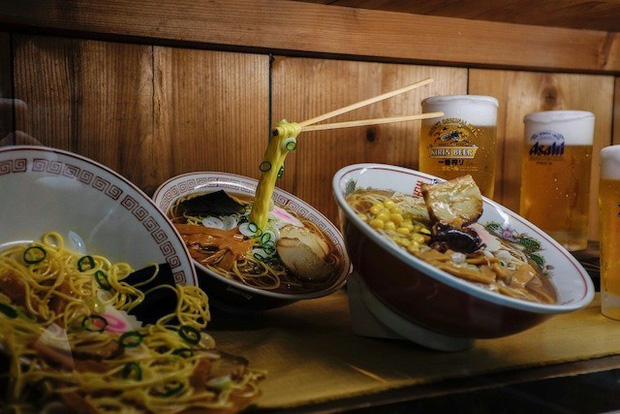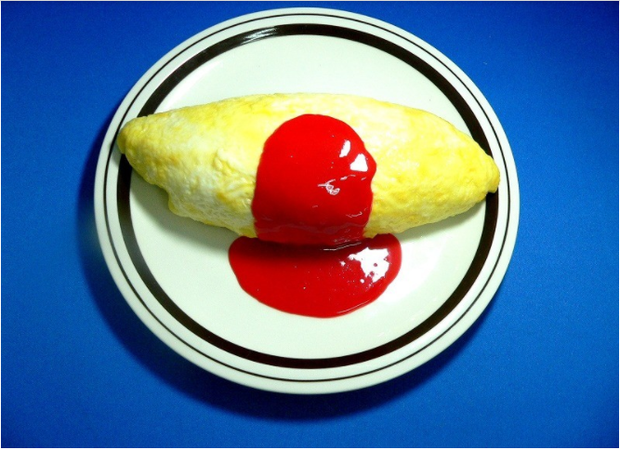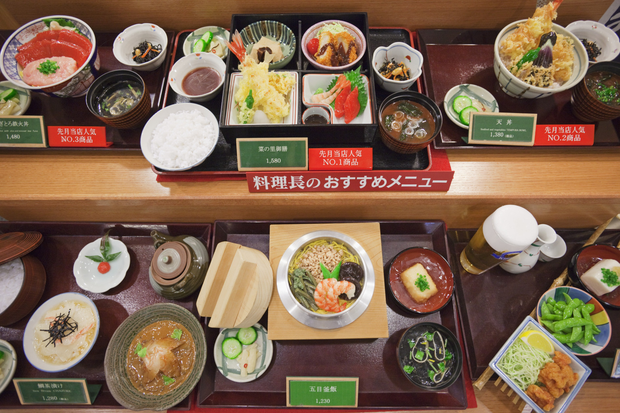
In the land of cherry blossoms, making fake food models is considered a form of craft art that requires elaborate, meticulous and long-standing tradition. In particular, this is also a profitable industry, earning a lot of profits for businesses.
This unique art is called Sampuru and has become a long-standing traditional culinary culture in Japan. Most restaurants, food stalls, supermarkets display fake products to illustrate the menu food for diners.
In addition to making the dish eye-catching, appealing and stimulating to the taste, the display of fake food also helps customers have an overview of the food they will choose. A great business strategy: what you see is what you get after ordering.
The idea came to surprise

However, few people know that the idea of making fake food first appeared in Japan in 1926, by Iwasaki Takizo – a citizen living in Osaka. This idea arose in a situation his family was having difficulties when his wife was seriously ill.
One night, Takizo sat next to his wife to care for her under the light of a candle in the room. His mood was confused because he didn’t know how to have money to make ends meet. Suddenly Takizo saw that the wax was flowing, he grabbed it with his finger and saw his fingerprints printed on the wax as the wax dried. Strangely enough, he continued to pour candle wax while it was melting down the mat and discovered that the wax piece when dry also clearly printed the line of projection.
And then he came up with the idea of making a dish out of candle wax. After a period of tinkering, learning from the craftsmen making candles with candles, Takizo made his own dishes. The first product he gave his wife was a model of omelet omelet coated with tomato sauce, and his wife was completely stunned because she could not distinguish between fake and real.

Later, Takizo saw the business potential in his replica products and decided to pioneer the creation of a new art form, becoming the standard for the food industry. This is considered a major change in the life of Iwasaki Takizo as well as in Japanese cuisine.
Iwasaki is truly a visionary as this is a “ripe” time for the revolution of making fake food models. The combination of urbanization, thriving culinary culture and the trend of enjoying exotic foods of countries created the cradle that nurtured Sampuru art in the 1920s.
A work of art requires many meticulous stages
“It’s already a Japanese tradition. The Japanese are very careful, they want to know in advance what they will look like,” said Fujita, 38, an artist who makes fake food. Journalist Yasunobu Nose, who once wrote a book on replica products, said that the art is rooted in the Japanese perspective: in addition to requiring food to be delicious, it must satisfy the sight of eater.
Each sampuru is a work of art and is almost handcrafted with the hands of skilled artisans. All fake food products are not mass produced, but each restaurant and restaurant will have its own requirements, no restaurant like any other restaurant. While many other companies also use a more affordable mass production model, people still prefer hand-crafted works, which are very expensive. Each sampuru model usually costs 10 to 20 times more than the price of the real dish.
According to Fujita, any food can be a fake model. First, the color-mixing plastic will be heated for 10-30 minutes, then poured into the mold (made by pressing the food to be made into molten silicon) and allowed to cool until hardened. Next, the artist will polish the block of product and then paint, and finally paint a glossy layer to preserve the surface color.
Fujita said the hardest part is how to make the fake products look as realistic as possible. And yet, all the small details must be imitated to look like them, so they are laborious to create each small part of the product with the number doubled, tripled. For example, if they wanted to model rice plates, they had to make individual rice grains individually by attaching glue to many white beads.
With chopsticks such as ramen, all the ingredients of the dish will be individually processed and then assembled into a bowl carefully. The artisans also shaped the products combined with chopsticks, spoons and decorated other items in the restaurant. The noodles are made from stretched plastic chains that bend like the real thing. Slices of pork, chopped garlic and half a hard-boiled egg will be meticulously molded before being placed in hard plastic broth.